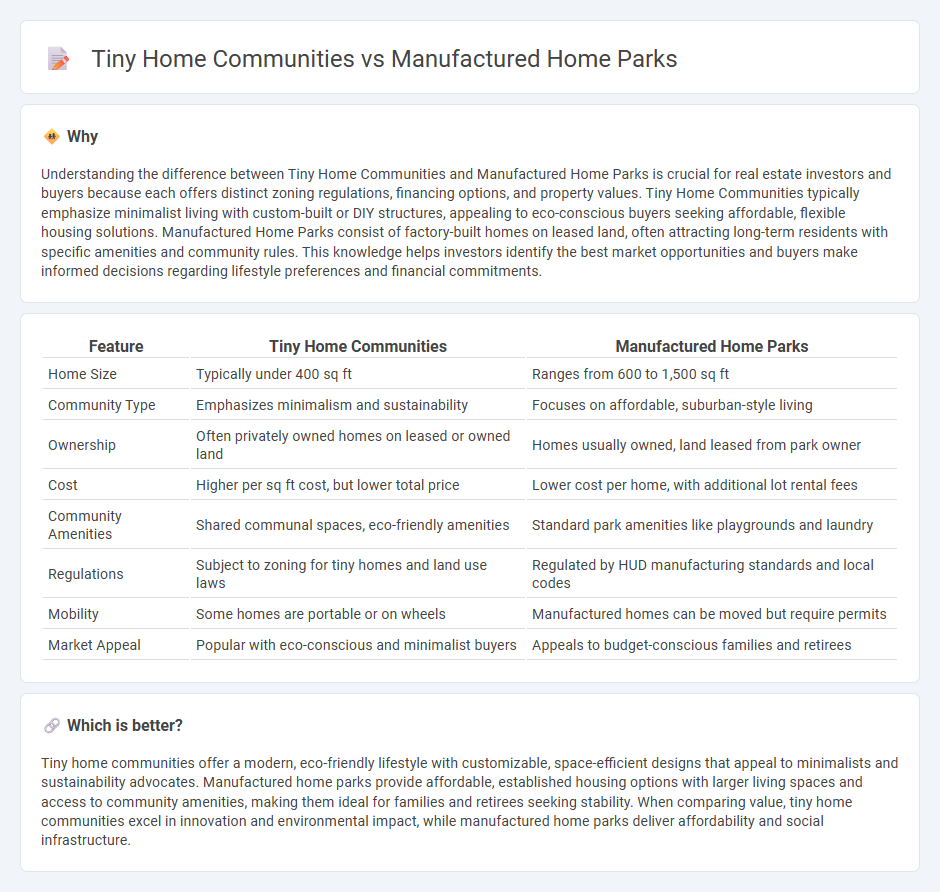
Tiny home communities offer affordable, eco-friendly living spaces with customizable designs and close-knit social environments, appealing to minimalist lifestyles and sustainability advocates. Manufactured home parks provide cost-effective housing with established infrastructure, often serving retirees and families seeking stable, long-term residence options. Explore the key differences and benefits of tiny home communities versus manufactured home parks to find the best fit for your housing needs.
Why it is important
Understanding the difference between Tiny Home Communities and Manufactured Home Parks is crucial for real estate investors and buyers because each offers distinct zoning regulations, financing options, and property values. Tiny Home Communities typically emphasize minimalist living with custom-built or DIY structures, appealing to eco-conscious buyers seeking affordable, flexible housing solutions. Manufactured Home Parks consist of factory-built homes on leased land, often attracting long-term residents with specific amenities and community rules. This knowledge helps investors identify the best market opportunities and buyers make informed decisions regarding lifestyle preferences and financial commitments.
Comparison Table
| Feature | Tiny Home Communities | Manufactured Home Parks |
|---|---|---|
| Home Size | Typically under 400 sq ft | Ranges from 600 to 1,500 sq ft |
| Community Type | Emphasizes minimalism and sustainability | Focuses on affordable, suburban-style living |
| Ownership | Often privately owned homes on leased or owned land | Homes usually owned, land leased from park owner |
| Cost | Higher per sq ft cost, but lower total price | Lower cost per home, with additional lot rental fees |
| Community Amenities | Shared communal spaces, eco-friendly amenities | Standard park amenities like playgrounds and laundry |
| Regulations | Subject to zoning for tiny homes and land use laws | Regulated by HUD manufacturing standards and local codes |
| Mobility | Some homes are portable or on wheels | Manufactured homes can be moved but require permits |
| Market Appeal | Popular with eco-conscious and minimalist buyers | Appeals to budget-conscious families and retirees |
Which is better?
Tiny home communities offer a modern, eco-friendly lifestyle with customizable, space-efficient designs that appeal to minimalists and sustainability advocates. Manufactured home parks provide affordable, established housing options with larger living spaces and access to community amenities, making them ideal for families and retirees seeking stability. When comparing value, tiny home communities excel in innovation and environmental impact, while manufactured home parks deliver affordability and social infrastructure.
Connection
Tiny home communities and manufactured home parks share a focus on affordable, space-efficient housing solutions that maximize land use while fostering close-knit neighborhoods. Both leverage pre-fabricated construction methods to reduce costs and speed up development, attracting buyers seeking lower barriers to homeownership. These models contribute to diversifying residential real estate markets by offering sustainable alternatives to traditional single-family homes.
Key Terms
Zoning Regulations
Zoning regulations for manufactured home parks often require specific land use designations that accommodate larger structures and infrastructure, while tiny home communities face more challenges due to size restrictions and varied local ordinances. Manufactured home parks are typically classified under residential zoning with allowances for multiple units per lot, whereas tiny home communities may need special permits or variances depending on whether the homes are on wheels or permanent foundations. Explore detailed zoning frameworks and best practices to navigate the regulatory landscape for both housing models effectively.
Infrastructure (Utilities & Roads)
Manufactured home parks typically feature established infrastructure with paved roads, centralized water, sewer, and electrical systems designed to support higher population densities. Tiny home communities often rely on more flexible utility setups, including off-grid options like solar power and composting toilets, with roads that may be gravel or less formal to reduce costs. Explore the differences further to find the best fit for your housing needs and infrastructure preferences.
Ownership Structure
Manufactured home parks typically feature individual homeownership with tenants leasing the land, creating a dual-ownership model that impacts financial stability and community control. Tiny home communities often promote collective ownership or cooperative models, fostering shared responsibility and increased resident influence over community decisions. Explore in-depth comparisons of ownership structures to determine which option best fits your housing preferences and investment goals.
Source and External Links
Manufactured Home Parks Registration - This webpage provides information on registering manufactured home parks in New York, including the requirement to register twice a year and submit lot details online.
Mobile Home Parks - Cook Properties - Cook Properties offers a variety of manufactured home parks across New York, including communities like Isle of Pines and Lakeview.
13 Mobile Home Parks near NYC, NY - MHVillage lists mobile home parks near New York City, allowing users to search by community type and find available lots.
 dowidth.com
dowidth.com